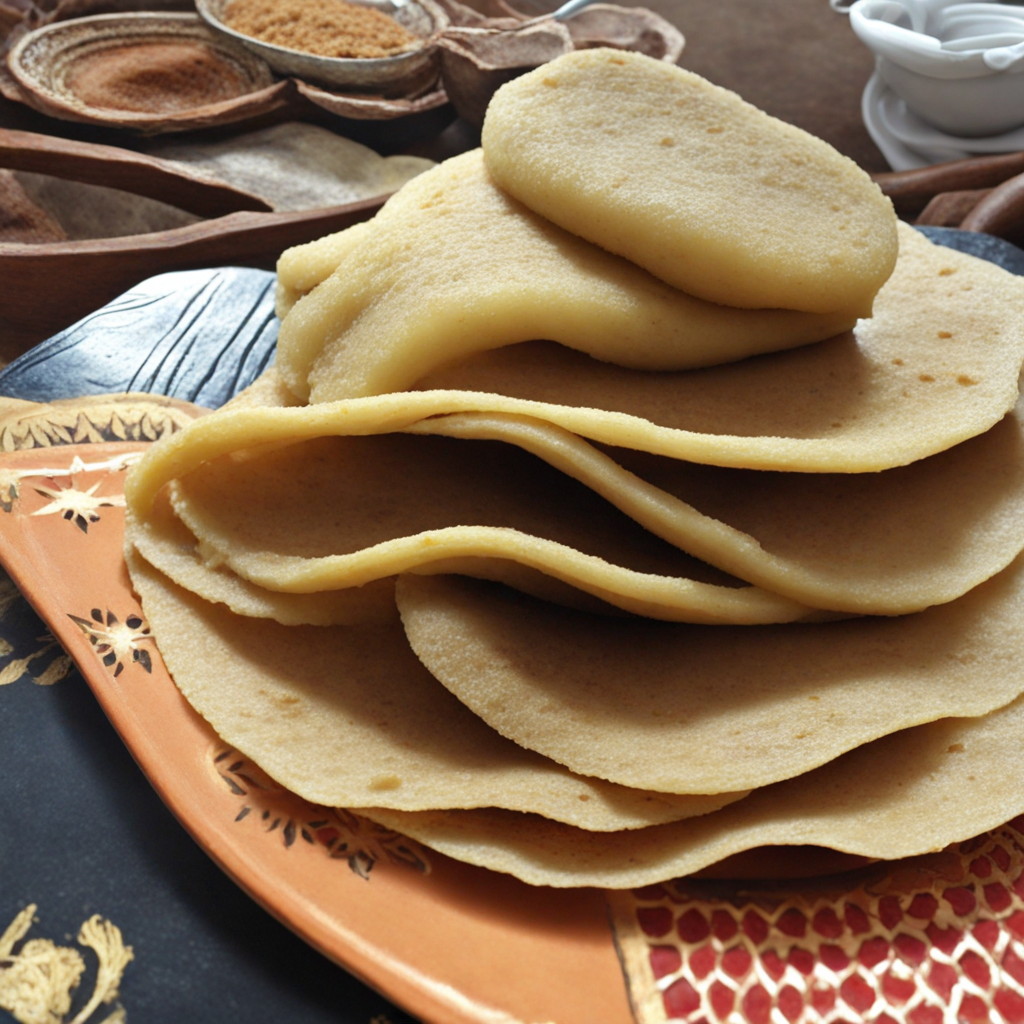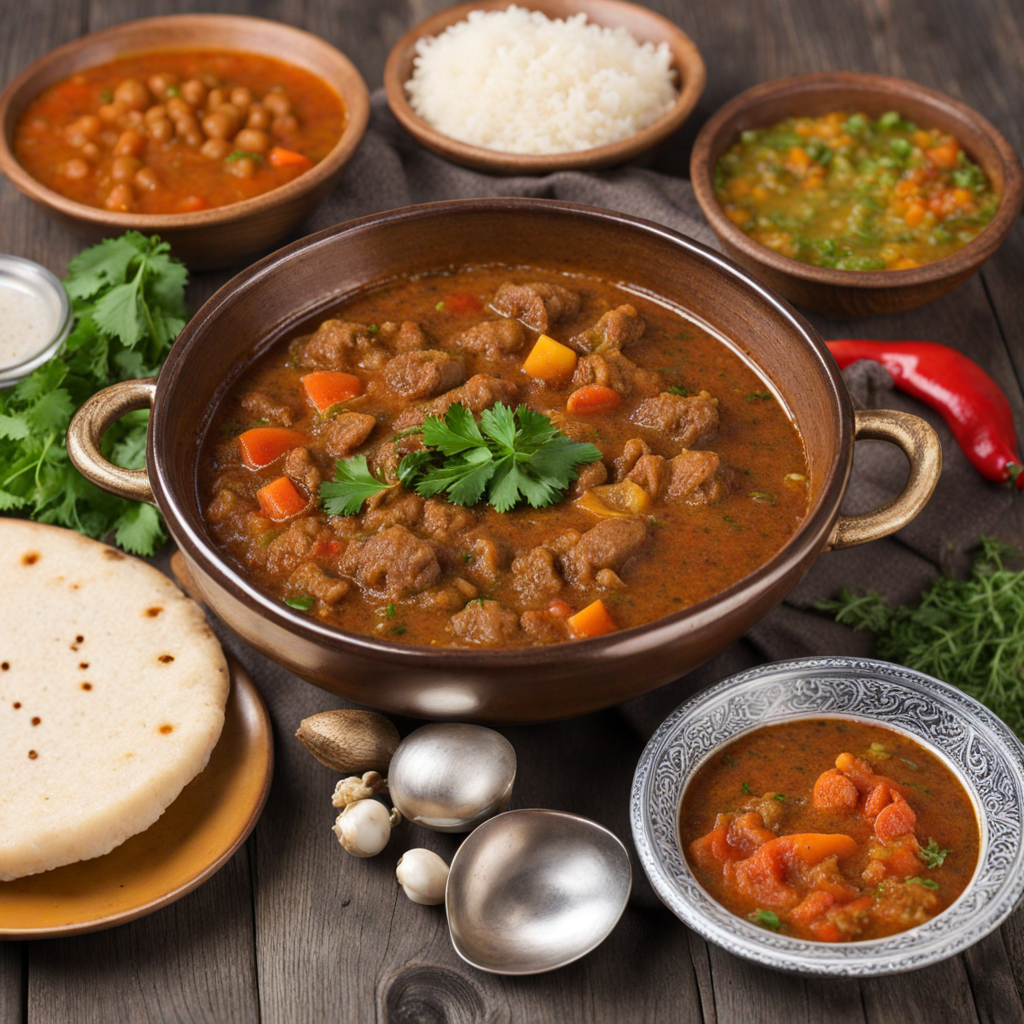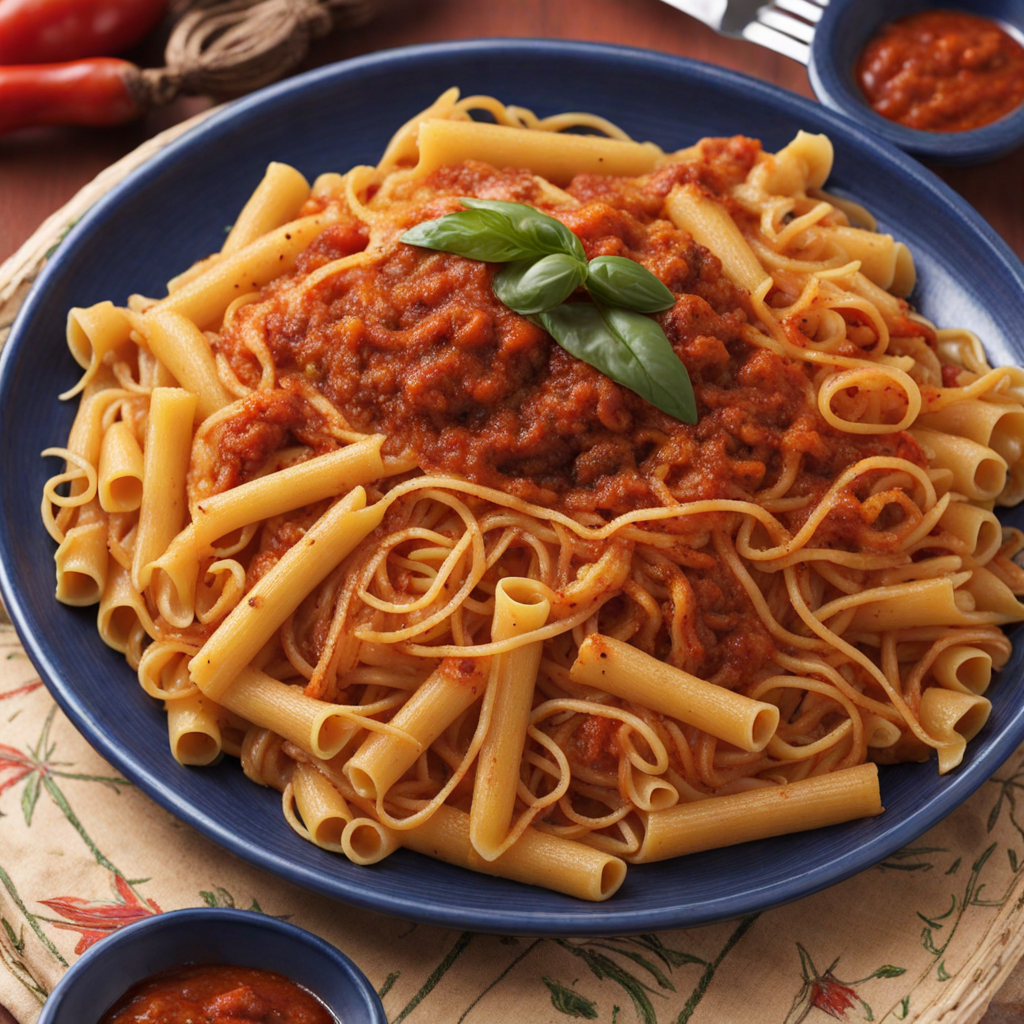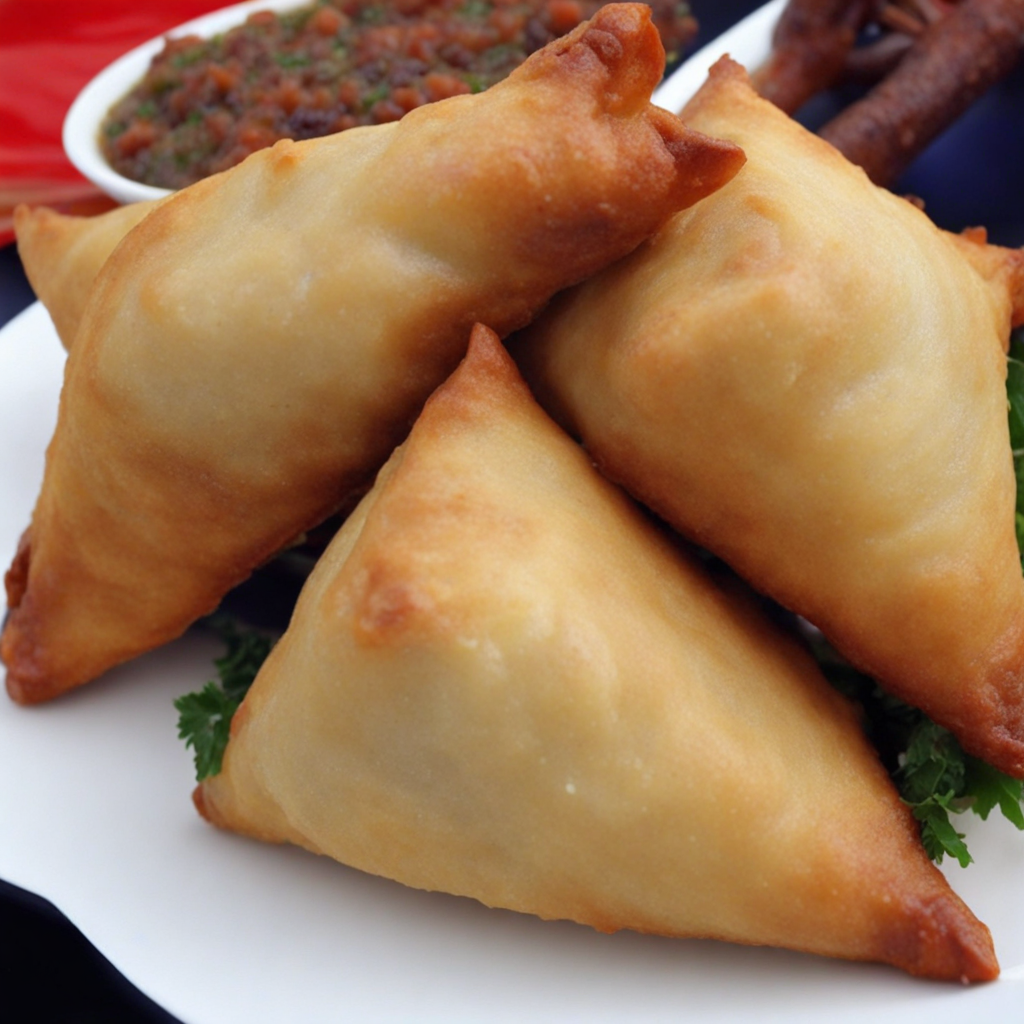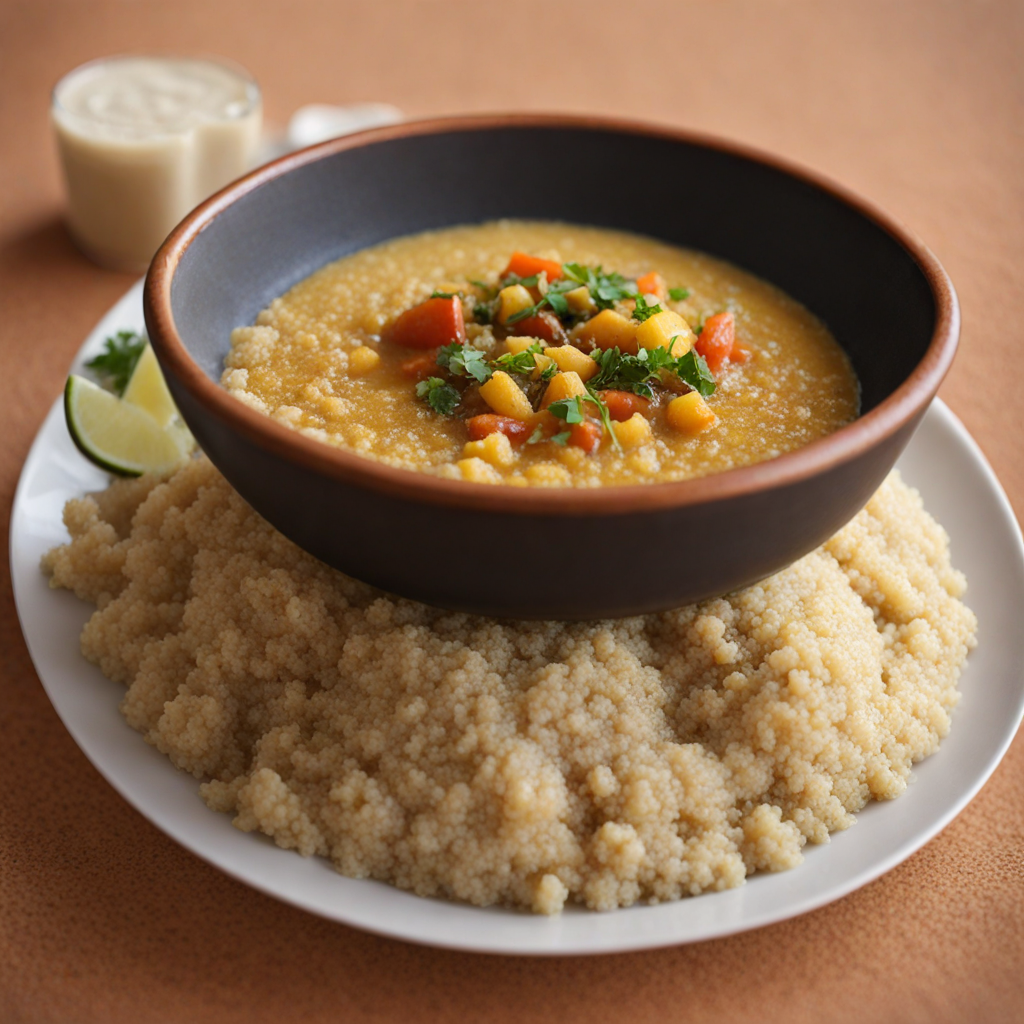Lahoh
Lahoh is a traditional Somali pancake that stands out for its unique texture and flavor. Made from a simple batter of flour, water, and yeast, this fermented delicacy is often compared to the Ethiopian injera due to its spongy consistency and slightly sour taste. Its light, airy bubbles create a textured surface that is perfect for soaking up sauces and stews, making it a versatile accompaniment to various dishes in Somali cuisine. Typically served warm, Lahoh can be enjoyed during any meal of the day. It is commonly paired with spicy stews, savory meats, or even sweet toppings like honey and sugar for breakfast. The pancake is often folded or rolled, allowing for an easy, hands-on eating experience that connects you to the communal aspect of Somali dining. The subtle tanginess of Lahoh enhances the flavors of the dishes it accompanies, providing a delightful contrast to rich, spicy sauces. What makes Lahoh particularly fascinating is the cultural significance it holds in Somali households. It is a staple food that brings people together, often prepared in large batches for family gatherings or celebrations. The process of making Lahoh can be seen as an art form, with skilled cooks mastering the technique of pouring the batter to create the perfect pancake. This beloved dish not only nourishes the body but also embodies the warmth and hospitality of Somali culture, inviting you to delve into a rich culinary tradition.
How It Became This Dish
The Culinary Journey of Lahuḥ: A Somali Delight Introduction Lahuḥ, also known as "lahuh" or "lahuh bread," is a traditional Somali flatbread that embodies the rich culinary tapestry of Somalia. This unique bread, characterized by its spongy texture and porous surface, serves not only as a staple food but also as a cultural symbol, reflecting the historical and social dynamics of the Somali people. Its origins, preparation techniques, and role in Somali society weave an intricate story that spans centuries. Origins of Lahuḥ The origins of lahuḥ can be traced back to the ancient trade routes that crossed the Horn of Africa, where Somalia is located. The region has long been a melting pot of cultures due to its strategic position along the coast of the Indian Ocean, facilitating trade with Arabian, Persian, and later European merchants. This confluence of cultures introduced various culinary influences that shaped the traditional foods of Somalia, including lahuḥ. The bread itself is likely a descendant of the ancient Ethiopian injera, a sourdough flatbread, with which it shares similarities in preparation and texture. The use of teff and other grains in the Horn of Africa's bread-making traditions served as a foundation for lahuḥ, which is primarily made from a mixture of wheat flour and water, sometimes incorporating yeast or fermented dough to create its characteristic texture. Cultural Significance In Somalia, lahuḥ is more than just a food item; it is a cultural emblem deeply rooted in communal and familial traditions. It is often served at breakfast, accompanied by various toppings such as honey, butter, or stews, making it an integral part of daily life. Its preparation and consumption are often communal activities, where families gather to make and share the bread, reinforcing social bonds and fostering a sense of community. Lahuḥ also plays a significant role during special occasions and celebrations. During Ramadan, for instance, it is often prepared as part of the iftar meal, breaking the fast with a warm piece of lahuḥ, complemented by dates and sweet milk. Its presence during weddings, holidays, and communal gatherings underscores its importance as a symbol of hospitality and generosity in Somali culture. Furthermore, lahuḥ has transcended its role as a mere food item to become a symbol of resilience and identity for the Somali people. Throughout history, Somalia has faced numerous challenges, including colonialism, civil war, and diaspora. In these contexts, traditional foods like lahuḥ serve as a reminder of home and heritage, connecting individuals to their roots and cultural narratives. Development Over Time The preparation of lahuḥ has evolved over the years, influenced by both local practices and external factors. Traditionally, lahuḥ was cooked on a clay griddle known as a "mijaal," which provided the bread with its unique texture and flavor. The mijaal, heated over an open flame, allows the bread to rise and form its characteristic holes. This method of cooking is still prevalent today, especially in rural areas where traditional practices are preserved. In urban centers, the introduction of modern kitchen appliances has transformed the way lahuḥ is prepared. Many households now use electric griddles or non-stick pans, which allow for greater convenience and consistency in cooking. However, despite these technological advancements, many Somali families continue to honor traditional methods, emphasizing the importance of cultural heritage in their culinary practices. The ingredients used in lahuḥ have also adapted over time. While wheat flour remains the primary component, the incorporation of other grains such as sorghum and millet reflects the agricultural diversity of Somalia. This adaptation is particularly significant in regions where wheat is scarce, allowing communities to maintain the practice of making lahuḥ while utilizing locally available resources. Global Influence and Diaspora As the Somali diaspora has spread across the globe, so too has the popularity of lahuḥ. Somali communities in North America, Europe, and the Middle East have embraced the preparation and consumption of lahuḥ, introducing it to new audiences and contexts. In these diasporic settings, lahuḥ has become a bridge connecting the Somali community to its heritage, while also fostering cultural exchange with other culinary traditions. Restaurants serving Somali cuisine have emerged in various cities, showcasing lahuḥ as a key element of their menus. Its versatility allows it to be paired with a range of dishes, from spicy stews to fresh salads, appealing to diverse palates. This globalization of lahuḥ has not only contributed to the preservation of Somali culinary traditions but has also facilitated the dissemination of knowledge about Somali culture and history. Lahuḥ in Contemporary Culture In contemporary Somalia, lahuḥ continues to hold a revered place in everyday life. While the country grapples with modernization and globalization, traditional foods remain a cornerstone of culinary identity. The resurgence of interest in local food production, sustainability, and traditional cooking methods has led to a renewed appreciation for lahuḥ and other indigenous foods. Moreover, social media has played a pivotal role in the popularization of lahuḥ among younger generations. Platforms like Instagram and TikTok have allowed food enthusiasts to share their experiences with lahuḥ, showcasing its preparation and various serving styles. This visibility not only promotes lahuḥ as a delicious and unique dish but also serves to educate others about Somali culture and traditions. Conclusion Lahuḥ is more than just a flatbread; it is a testament to the resilience, creativity, and cultural richness of the Somali people. Its origins, deeply rooted in the historical trade networks of the Horn of Africa, have evolved into a culinary phenomenon that resonates with both tradition and modernity. As a symbol of community, hospitality, and identity, lahuḥ continues to play an essential role in Somali life, bridging the past and present while fostering connections among generations. In the face of globalization, lahuḥ stands as a proud emblem of Somali heritage, reminding us of the power of food to connect us to our roots, our communities, and each other. Whether shared at a family gathering, enjoyed during a festive occasion, or featured in a global culinary landscape, lahuḥ remains a cherished symbol of Somali culture, history, and resilience—an enduring legacy on every plate.
You may like
Discover local flavors from Somalia


